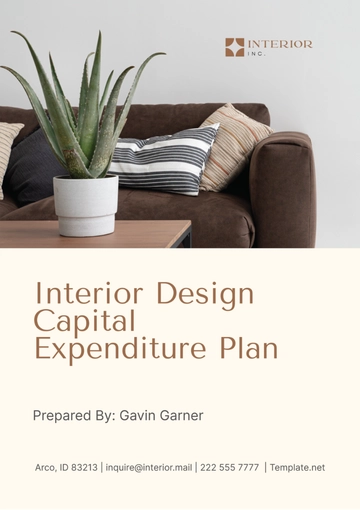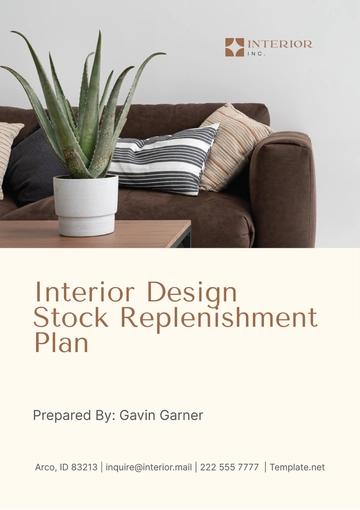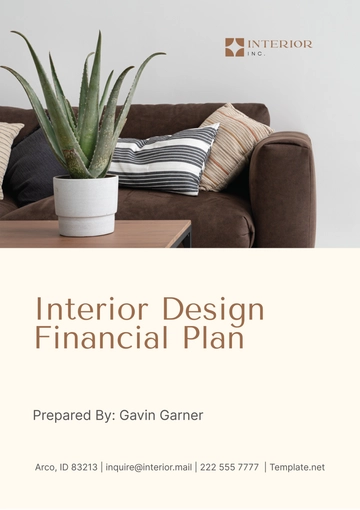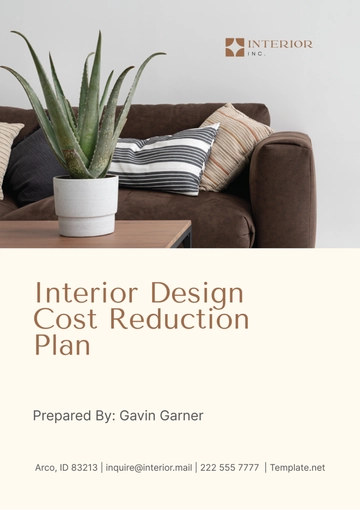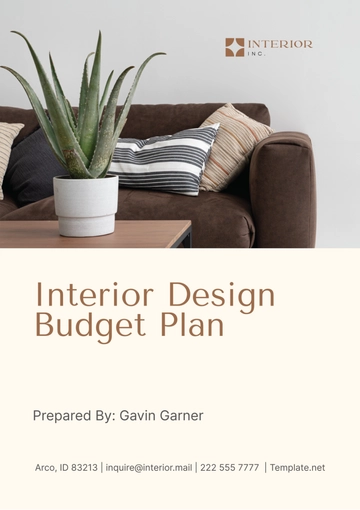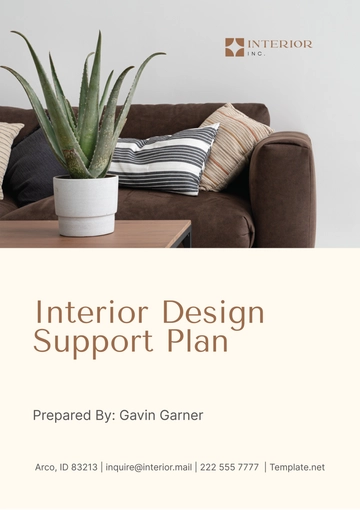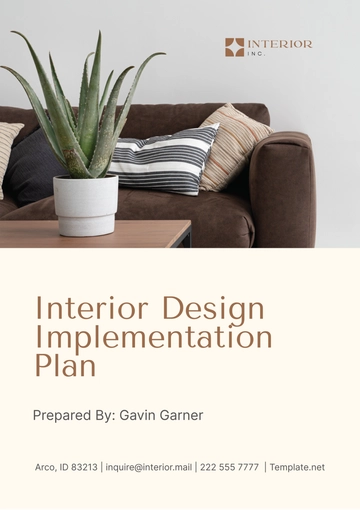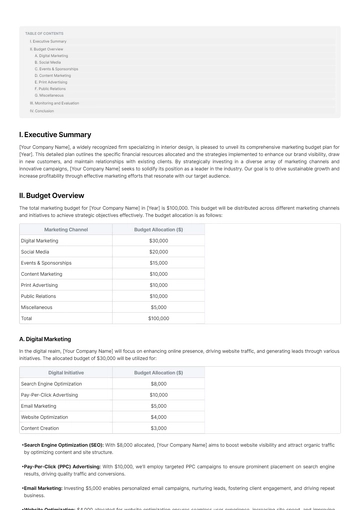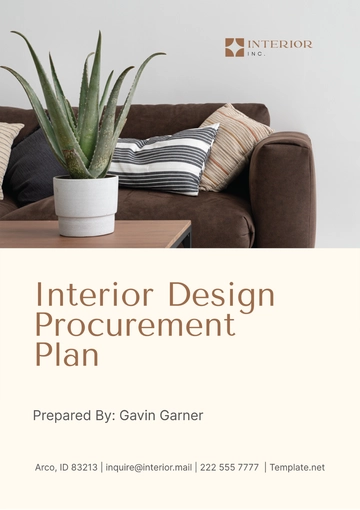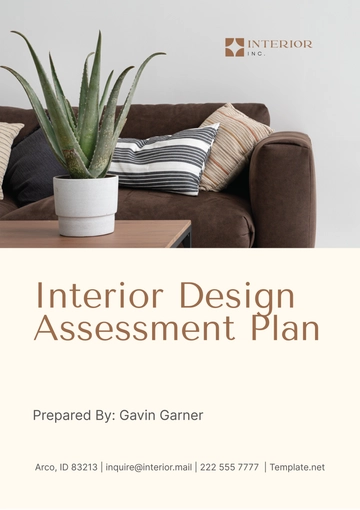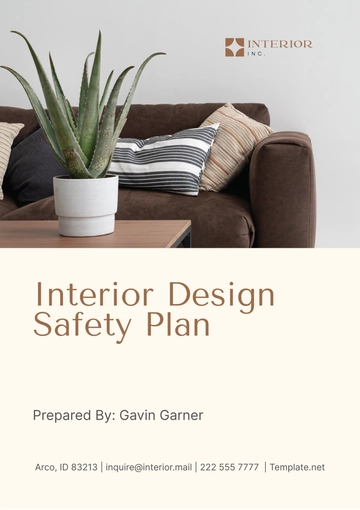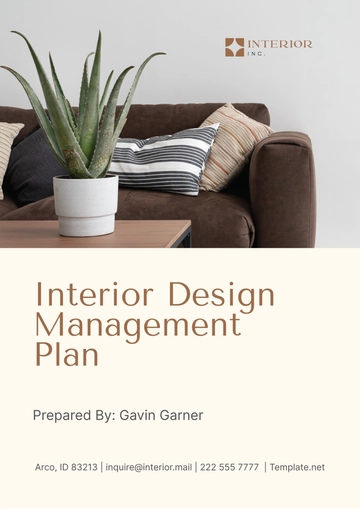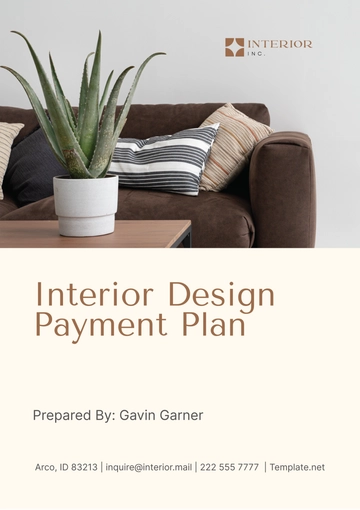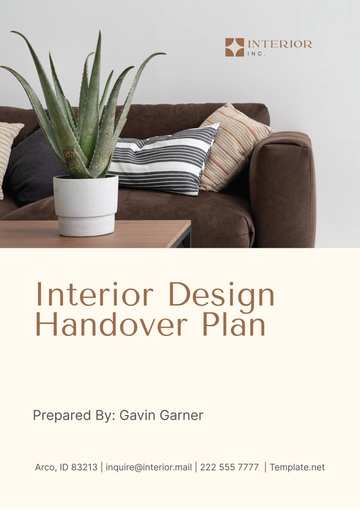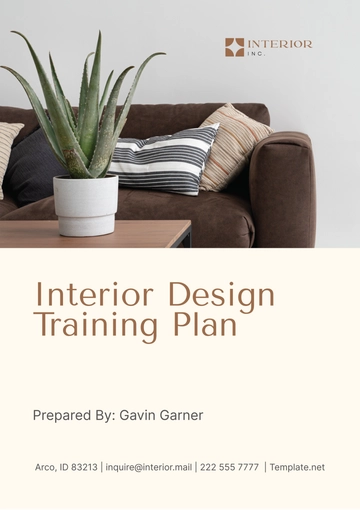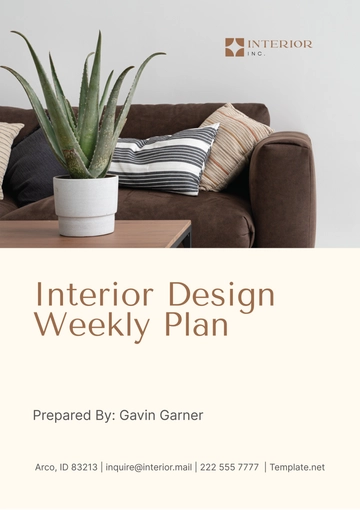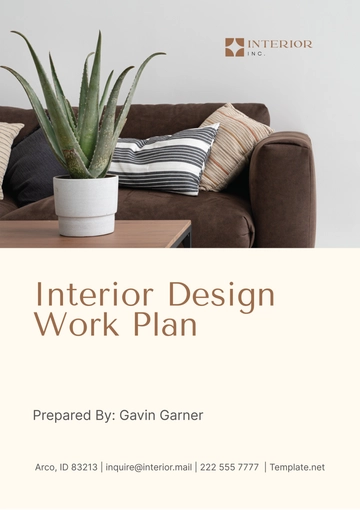Free Interior Design Financial Plan
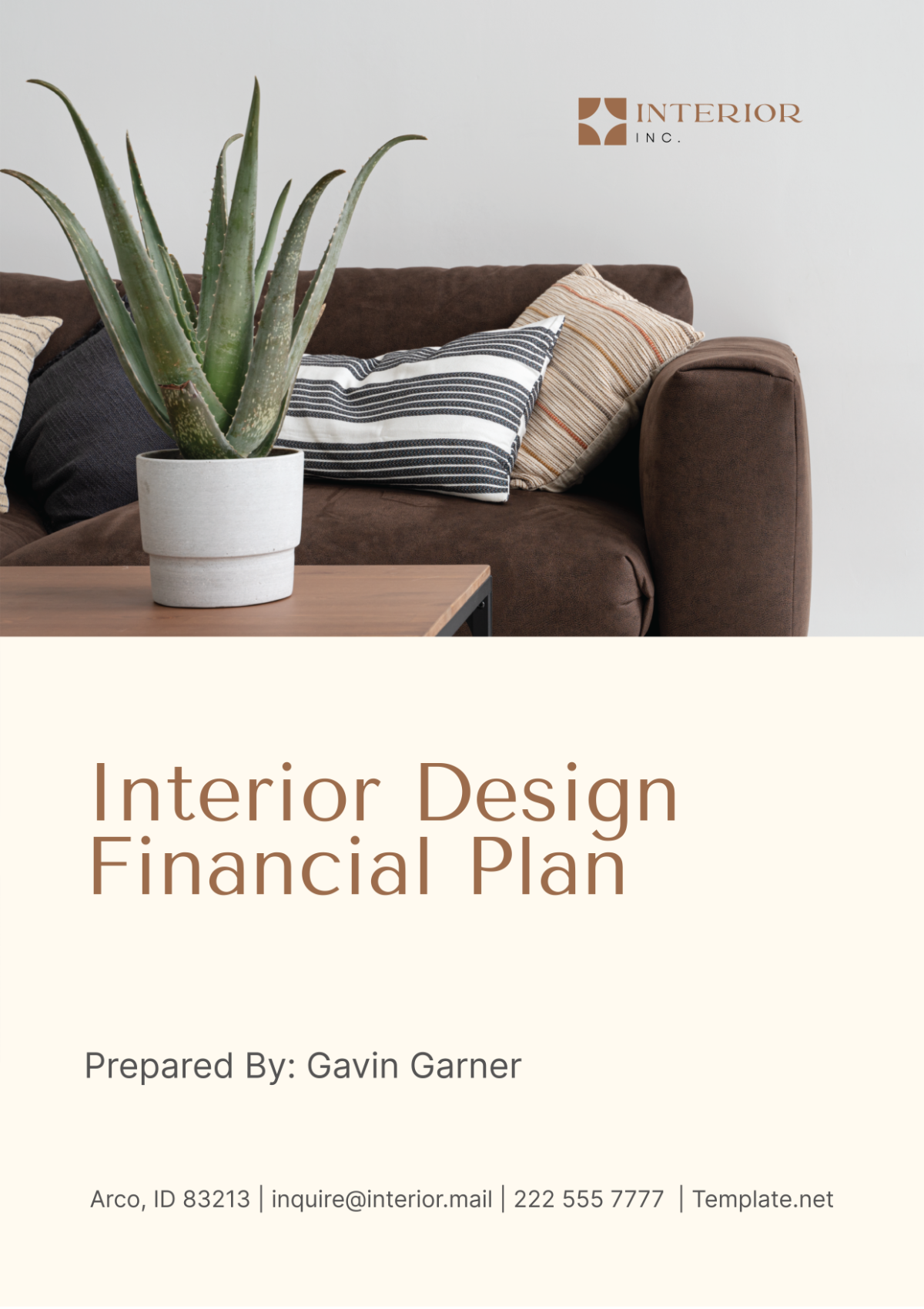
I. Executive Summary
A. Overview
[Your Company Name], known for its innovative and personalized interior design solutions, aims to continue its success over the next three years. This financial plan presents a comprehensive forecast of revenues, expenses, and profitability, outlining the strategies to achieve sustainable growth and maintain profitability.
B. Objectives
Achieve a minimum annual revenue growth rate of 15%.
Maintain a net profit margin of 20% through efficient cost management and strategic pricing.
Expand the client base by 25% through targeted marketing campaigns and referrals.
C. Financial Highlights
Projected total revenue for Year 1: $500,000
Anticipated net profit margin for Year 1: 22%
Estimated break-even point: Month 6 of Year 1
II. Business Description
A. Company Background
[Your Company Name] is a boutique interior design firm based in New York City, established in 2050 by renowned designer [Your Name]. With over a decade of experience in the industry, [Your Company Name] has earned a reputation for delivering cutting-edge designs tailored to the unique preferences of each client.
B. Services Offered
Service | Description |
|---|---|
Residential Interior Design | Designing living spaces tailored to clients' lifestyles. |
Commercial Interior Design | Creating innovative work environments that reflect brand identity and enhance productivity. |
Space Planning and Layout | Optimizing spatial configurations to maximize functionality and flow. |
Material Selection and Procurement | Sourcing high-quality materials and furnishings from trusted suppliers. |
Project Management | Overseeing all aspects of the design process, from concept development to final installation. |
III. Market Analysis
A. Target Market
[Your Company Name] targets two primary segments: affluent homeowners seeking luxurious residential designs and business owners looking to enhance their commercial spaces.
For residential clients, the target demographic includes high-income individuals aged 30-60 residing in urban and suburban areas, with a focus on major metropolitan areas such as New York City, Los Angeles, and Chicago.
Commercial clients consist of small to medium-sized businesses, boutique hotels, and upscale restaurants seeking to differentiate themselves through innovative interior design solutions.
Psychographically, the target market values exclusivity, quality craftsmanship, and personalized service.
B. Industry Trends
The interior design industry is experiencing a shift towards sustainable and eco-friendly design practices, driven by increasing environmental awareness among consumers.
Wellness-oriented interiors, featuring elements such as biophilic design and ergonomic furniture, are gaining popularity as businesses prioritize employee well-being and productivity.
Integration of smart home technologies, including automated lighting systems and voice-controlled appliances, is becoming increasingly prevalent in residential design projects.
C. Competitor Analysis
Competitor A: A well-established interior design firm with a strong presence in the luxury residential market, known for its classic yet timeless designs.
Competitor B: A boutique design studio specializing in modern and minimalist interiors, catering primarily to urban professionals and small businesses.
Competitor C: A full-service design agency offering a wide range of design services, including interior design, architecture, and landscaping, targeting high-end residential and commercial clients.
IV. Marketing Strategy
A. Branding and Positioning
[Your Company Name] positions itself as a provider of bespoke, luxury interior design solutions, distinguished by its attention to detail, creative flair, and personalized approach.
Brand Identity:
Logo: A sleek and sophisticated emblem featuring abstract design elements that convey creativity and sophistication.
Colors: A palette of rich, earthy tones combined with metallic accents to evoke a sense of luxury and elegance.
Fonts: Clean and modern typefaces that reflect the brand's commitment to contemporary design aesthetics.
Brand Message: "Elevate Your Space with [Your Company Name] – Where Imagination Meets Innovation."
B. Promotional Channels
Social Media Marketing: Leveraging platforms such as Instagram and Pinterest to showcase portfolio projects, share design inspiration, and engage with followers.
Website Optimization: Maintaining a visually stunning and user-friendly website that highlights the company's portfolio, services, and client testimonials.
Networking Events: Participating in industry events, trade shows, and networking mixers to connect with potential clients, industry professionals, and suppliers.
Collaborations with Industry Partners: Forming strategic partnerships with architects, contractors, and furniture manufacturers to expand the company's reach and enhance service offerings.
C. Sales Forecast
Monthly Sales Projections for Year 1
Month | Revenue ($) |
|---|---|
January | $40,000 |
February | $45,000 |
March | $50,000 |
April | $55,000 |
May | $60,000 |
June | $65,000 |
July | $70,000 |
August | $75,000 |
September | $80,000 |
October | $85,000 |
November | $90,000 |
December | $95,000 |
V. Operational Plan
A. Business Processes
Client Consultation: Conducting in-depth consultations with clients to understand their needs, preferences, and budgetary constraints.
Design Development: Collaborating with clients to develop conceptual designs and mood boards that capture the desired aesthetic and functionality.
Procurement and Vendor Management: Sourcing materials, furniture, and accessories from reputable suppliers while ensuring timely delivery and adherence to quality standards.
Project Execution and Installation: Overseeing all aspects of the design implementation process, including construction, installation, and finishing touches.
Quality Assurance and Client Satisfaction: Conducting post-installation inspections and soliciting feedback from clients to ensure their satisfaction with the final result.
B. Resource Allocation
Human Resources: Employing a team of experienced interior designers, project managers, and administrative staff to execute projects efficiently and provide exceptional customer service.
Material Resources: Maintaining relationships with a network of trusted suppliers and vendors to ensure access to high-quality materials and furnishings.
Financial Resources: Allocating funds for operating expenses, marketing initiatives, professional development, and contingencies to support business growth and stability.
C. Operational Timeline
Projected Timeline for Key Operational Activities
Activity | Timeline |
|---|---|
Client Consultation | Week 1-2 |
Design Development | Week 3-4 |
Procurement | Week 5-6 |
Project Execution and Installation | Week 7-10 |
Quality Assurance and Client Satisfaction | Week 11-12 |
VI. Financial Plan
A. Revenue Projections
Annual Revenue Forecast for Years 1-3
Year | Revenue ($) |
|---|---|
Year 1 | $500,000 |
Year 2 | $600,000 |
Year 3 | $720,000 |
B. Expense Projections
Breakdown of Operating Expenses by Category
Category | Expense ($) |
|---|---|
Personnel Costs | $250,000 |
Marketing Expenses | $50,000 |
Office Rent | $60,000 |
Utilities | $10,000 |
Supplies | $20,000 |
Insurance | $15,000 |
Miscellaneous | $15,000 |
C. Profitability Analysis
Gross Profit Margin: 50%
Net Profit Margin: 22%
VII. Risk Management
A. Identification of Risks
Economic Downturn: A recession or economic downturn could lead to reduced consumer spending on luxury goods and services, impacting the demand for interior design services.
Supply Chain Disruptions: Delays or disruptions in the supply chain, such as shortages of materials or labor, could hinder project timelines and increase costs.
Regulatory Changes: Changes in regulations related to building codes, environmental standards, or business licensing requirements could necessitate costly adaptations or compliance measures.
B. Mitigation Strategies
Diversification of Revenue Streams: By offering additional services such as virtual design consultations, home staging, or design workshops, [Your Company Name] can mitigate the impact of fluctuations in demand for traditional design services.
Supplier Relationship Management: Cultivating strong relationships with key suppliers and maintaining alternative sources of materials can help mitigate the risk of supply chain disruptions.
Compliance with Industry Standards: Staying abreast of regulatory changes and proactively implementing necessary measures ensures [Your Company Name] remains in compliance with relevant regulations and standards.
C. Contingency Plan
Establishment of Emergency Fund: Setting aside funds for unforeseen expenses or downturns in business activity provides a financial safety net during challenging times.
Development of Alternative Revenue Models: Exploring new revenue streams, such as offering online design courses or licensing design templates, can provide additional income sources and mitigate reliance on traditional design projects.
VIII. Conclusion
A. Summary of Key Findings
[Your Company Name] is well-positioned to capitalize on opportunities in the interior design market, with a strong brand reputation and a diverse portfolio of services. The financial projections indicate steady revenue growth and healthy profit margins, supported by strategic marketing initiatives and efficient operational processes.
B. Future Outlook
Opportunities for Growth and Expansion: [Your Company Name] plans to explore opportunities for geographic expansion and diversification of service offerings, including entry into emerging markets and partnerships with complementary businesses.
Commitment to Financial Stability and Sustainability: [Your Company Name] remains committed to maintaining financial stability, investing in professional development, and delivering exceptional value to clients, ensuring long-term success and sustainability.
- 100% Customizable, free editor
- Access 1 Million+ Templates, photo’s & graphics
- Download or share as a template
- Click and replace photos, graphics, text, backgrounds
- Resize, crop, AI write & more
- Access advanced editor
Ensure financial stability and growth with Template.net's Interior Design Financial Plan Template. This customizable document provides a structured framework for outlining financial goals, projections, and strategies for your interior design business. Plan effectively for revenue generation, expenses, investments, and cash flow management. Editable in our Ai Editor Tool for seamless customization to align with your business objectives and financial targets.
You may also like
- Finance Plan
- Construction Plan
- Sales Plan
- Development Plan
- Career Plan
- Budget Plan
- HR Plan
- Education Plan
- Transition Plan
- Work Plan
- Training Plan
- Communication Plan
- Operation Plan
- Health And Safety Plan
- Strategy Plan
- Professional Development Plan
- Advertising Plan
- Risk Management Plan
- Restaurant Plan
- School Plan
- Nursing Home Patient Care Plan
- Nursing Care Plan
- Plan Event
- Startup Plan
- Social Media Plan
- Staffing Plan
- Annual Plan
- Content Plan
- Payment Plan
- Implementation Plan
- Hotel Plan
- Workout Plan
- Accounting Plan
- Campaign Plan
- Essay Plan
- 30 60 90 Day Plan
- Research Plan
- Recruitment Plan
- 90 Day Plan
- Quarterly Plan
- Emergency Plan
- 5 Year Plan
- Gym Plan
- Personal Plan
- IT and Software Plan
- Treatment Plan
- Real Estate Plan
- Law Firm Plan
- Healthcare Plan
- Improvement Plan
- Media Plan
- 5 Year Business Plan
- Learning Plan
- Marketing Campaign Plan
- Travel Agency Plan
- Cleaning Services Plan
- Interior Design Plan
- Performance Plan
- PR Plan
- Birth Plan
- Life Plan
- SEO Plan
- Disaster Recovery Plan
- Continuity Plan
- Launch Plan
- Legal Plan
- Behavior Plan
- Performance Improvement Plan
- Salon Plan
- Security Plan
- Security Management Plan
- Employee Development Plan
- Quality Plan
- Service Improvement Plan
- Growth Plan
- Incident Response Plan
- Basketball Plan
- Emergency Action Plan
- Product Launch Plan
- Spa Plan
- Employee Training Plan
- Data Analysis Plan
- Employee Action Plan
- Territory Plan
- Audit Plan
- Classroom Plan
- Activity Plan
- Parenting Plan
- Care Plan
- Project Execution Plan
- Exercise Plan
- Internship Plan
- Software Development Plan
- Continuous Improvement Plan
- Leave Plan
- 90 Day Sales Plan
- Advertising Agency Plan
- Employee Transition Plan
- Smart Action Plan
- Workplace Safety Plan
- Behavior Change Plan
- Contingency Plan
- Continuity of Operations Plan
- Health Plan
- Quality Control Plan
- Self Plan
- Sports Development Plan
- Change Management Plan
- Ecommerce Plan
- Personal Financial Plan
- Process Improvement Plan
- 30-60-90 Day Sales Plan
- Crisis Management Plan
- Engagement Plan
- Execution Plan
- Pandemic Plan
- Quality Assurance Plan
- Service Continuity Plan
- Agile Project Plan
- Fundraising Plan
- Job Transition Plan
- Asset Maintenance Plan
- Maintenance Plan
- Software Test Plan
- Staff Training and Development Plan
- 3 Year Plan
- Brand Activation Plan
- Release Plan
- Resource Plan
- Risk Mitigation Plan
- Teacher Plan
- 30 60 90 Day Plan for New Manager
- Food Safety Plan
- Food Truck Plan
- Hiring Plan
- Quality Management Plan
- Wellness Plan
- Behavior Intervention Plan
- Bonus Plan
- Investment Plan
- Maternity Leave Plan
- Pandemic Response Plan
- Succession Planning
- Coaching Plan
- Configuration Management Plan
- Remote Work Plan
- Self Care Plan
- Teaching Plan
- 100-Day Plan
- HACCP Plan
- Student Plan
- Sustainability Plan
- 30 60 90 Day Plan for Interview
- Access Plan
- Site Specific Safety Plan
